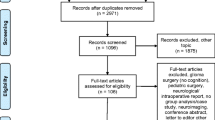Abstract
In surgery for tumors of the dominant hemisphere, the attention devoted to quality of resection and preservation of language function has not been accompanied by comparable interest in preservation of cognitive abilities which may affect quality of life. We studied 22 patients undergoing awake surgery for glioma removal in the language areas of the brain. Besides monitoring tumor variables (size, location, histology, edema), we used a multifaceted battery of tests to investigate mood, cognition, and language in an attempt to assess the burden of disease and treatment, and the relationships between these three dimensions. Baseline assessment showed that 45% of the patients were depressed and 23% anxious; some cognitive and language impairment was noted for 59 and 50%, respectively. A general decline in postoperative cognitive performance (significant for memory and attention only) and language function (significant for picture naming) was observed, whereas depression was unchanged and anxiety decreased. Tumor histology, but not demographic variables or extent of resection, correlated with postoperative cognitive changes: patients undergoing surgery for high-grade tumors were more likely to improve. No correlation was observed between scores for mood, cognition, and language function. A subset of patients with low-grade glioma was followed up for 3–6 months; although some improvement was observed they did not always regain their preoperative performance. In conclusion, we believe that cognitive assessment performed in conjunction with language testing is a necessary step in the global evaluation of brain tumor patients both before and after surgery.
Similar content being viewed by others
References
Duffau H, Peggy Gatignol ST, Mandonnet E, Capelle L, Taillandier L (2008) Intraoperative subcortical stimulation mapping of language pathways in a consecutive series of 115 patients with Grade II glioma in the left dominant hemisphere. J Neurosurg 109(3):461–471
Berger MS, Ojemann GA (1992) Intraoperative brain mapping in neurooncology. Stereotact Funct Neurosurg 58(1–4):153–61 (review)
Ojemann G, Ojemann J, Lettich E, Berger M (1989) Cortical language localization in left, dominant hemisphere. An electrical stimulation mapping investigation in 117 patients. J Neurosurg 71(3):316–326
Sanai N, Berger MS (2008) Glioma extent of resection and its impact on patient outcome. Neurosurgery 62(2):753–766
Tucha O, Smely C, Preier M, Lange KW (2000) Cognitive deficits before treatment among patients with brain tumors. Neurosurgery 47:324–333
Talacchi A, Santini B, Savazzi S, Gerosa M (2010) Cognitive effects of tumour and surgical treatment in glioma patients. J Neurooncol 103(3):541–9 (Epub 2010 Sep 28)
Meyers CA, Brown PD (2006) Role and relevance of neurocognitive assessment in clinical trials of patients with CNS tumors. J Clin Oncol 24(8):1305–1309
Miceli G, Laudanna C, Burani C, Capasso R (1994) Batteria per l’analisi dei deficit afasici (BADA). Università Cattolica del Sacro Cuore Policlinico Gemelli/Cepsag, Rome
Oldfield RC (1971) The assessment and analyses of handedness: the Edinburgh inventory. Neuropsychologia 9:97–113
Caltagirone C, Perri R, Musicco M (2001) La fase preclinica della malattia di Alzheimer. Cortical Medicine, Rome
Giovagnoli AR, Del Pesce M, Mascheroni S, Simoncelli M, Laicona M, Capitani E (1996) Trail making test: normative values from 287 normal adult controls. Int J Neurol Sci 17:305–309
Spinnler H, Tognoni G (1987) Standardizzazione e taratura italiana di test neurologici. Ital J Neurol Sci 7(suppl. 8):1–120
Rey A (1983) Reattivo della figura complessa. Manuale Organizzazioni Speciali, Florence
Laiacona M, Barbarotto R, Trivelli C, Capitani E (1993) Dissociazioni semantiche intercategoriali: descrizione di una batteria standardizzata e dati normativi. Arch Psicol Neurol Psichiatr 54:209–248
Bisiach E, Cappa S, Vallar G (1983) Guida all’esame neuropsicologico. Raffaello Cortina, Milan
Beck TA (1972) Depression causes and treatment. University of Pennsylvania Press, Philadelphia
Spielberger CD (1970) STAI state-trait anxiety inventory Forma Y. Organizzazioni Speciali, Florence
Pringle A-M, Taylor R, Whittle JR (1999) Anxiety and depression in patients with an intracranial neoplasm before and after tumor surgery. Br J Neurosurg 13(1):46–51
Grant R, Slattery J, Gregor A, Whittle IR (1994) Recording neurological impairment in clinical trials of glioma. J Neuro Oncol 19:37–49
Keles GE, Lundin DA, Lamborn KR, Chang EF, Ojemann G, Berger MS (2004) Intraoperative subcortical stimulation mapping for hemispherical perirolandic gliomas located within or adjacent to the descending motor pathways: evaluation of morbidity and assessment of functional outcome in 294 patients. J Neurosurg 100(3):369–375
Giovagnoli AR, Boiardi A (1994) Cognitive impairment and quality of life in long-term survivors of malignant brain tumors. Ital J Neurol Sci 15:481–488
Palson A, Ek L, Ahlstrom G, Smita A (2003) Pitfalls in the assessment of disability in individual with low-grade gliomas. J Neuro Oncol 65:149–158
Yoshii Y, Tominaga D, Sugimoto K, Tsuchida Y, Hyodo A, Yonaha H, Kushi S (2006) Cognitive function of patients with brain tumor in pre- and postoperative stage. Surg Neurol 69:51–61
Braun V, Albrecht A, Kretschmer T, Richtrer H-P, Wunderlich A (2004) Brain tumour surgery in the vicinity of short term memory representation—results of neuronavigation using fMRI images. Acta Neurochirurgica (Wien) 148:733–739
Teixidor P, Gatignol P, Leroy M, Aumatell C, Capelle L, Duffau H (2007) Assessment of verbal working memory before and after surgery for low-grade glioma. J Neuro Oncol 81:305–313
Wu A, Witgert M, Lang FF, Xiao L, Bekele BN, Meyers CA, Ferson D, Wefel JS (2010). Neurocognitive before and after surgery for inular glioma. J Neurosurg 115(6):1115s–1125s
Goldstein B, Obrzut JE, John C, Hunter JV, Armstrong CL (2004) The impact of low-grade brain tumors on verbal fluency performance. J Clin Exp Neuropsychol 26(6):750–758
Conflict of interest
The authors report no conflict of interest concerning the materials or methods used in this study or the findings specified in this paper.
Author information
Authors and Affiliations
Corresponding author
Rights and permissions
About this article
Cite this article
Santini, B., Talacchi, A., Squintani, G. et al. Cognitive outcome after awake surgery for tumors in language areas. J Neurooncol 108, 319–326 (2012). https://doi.org/10.1007/s11060-012-0817-4
Received:
Accepted:
Published:
Issue Date:
DOI: https://doi.org/10.1007/s11060-012-0817-4




